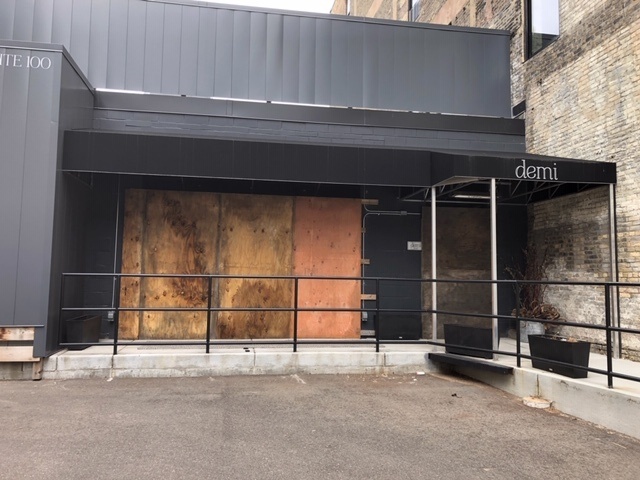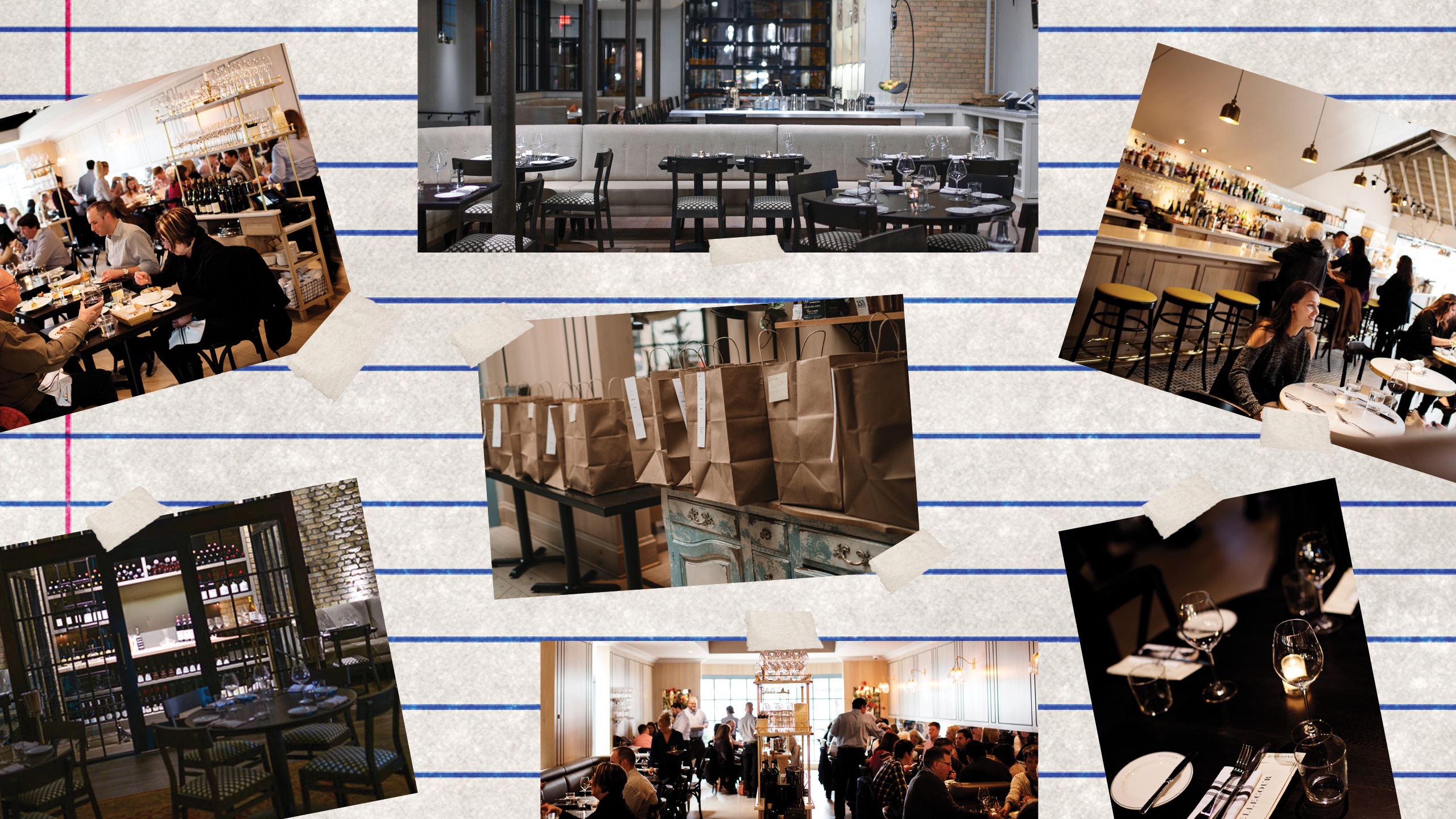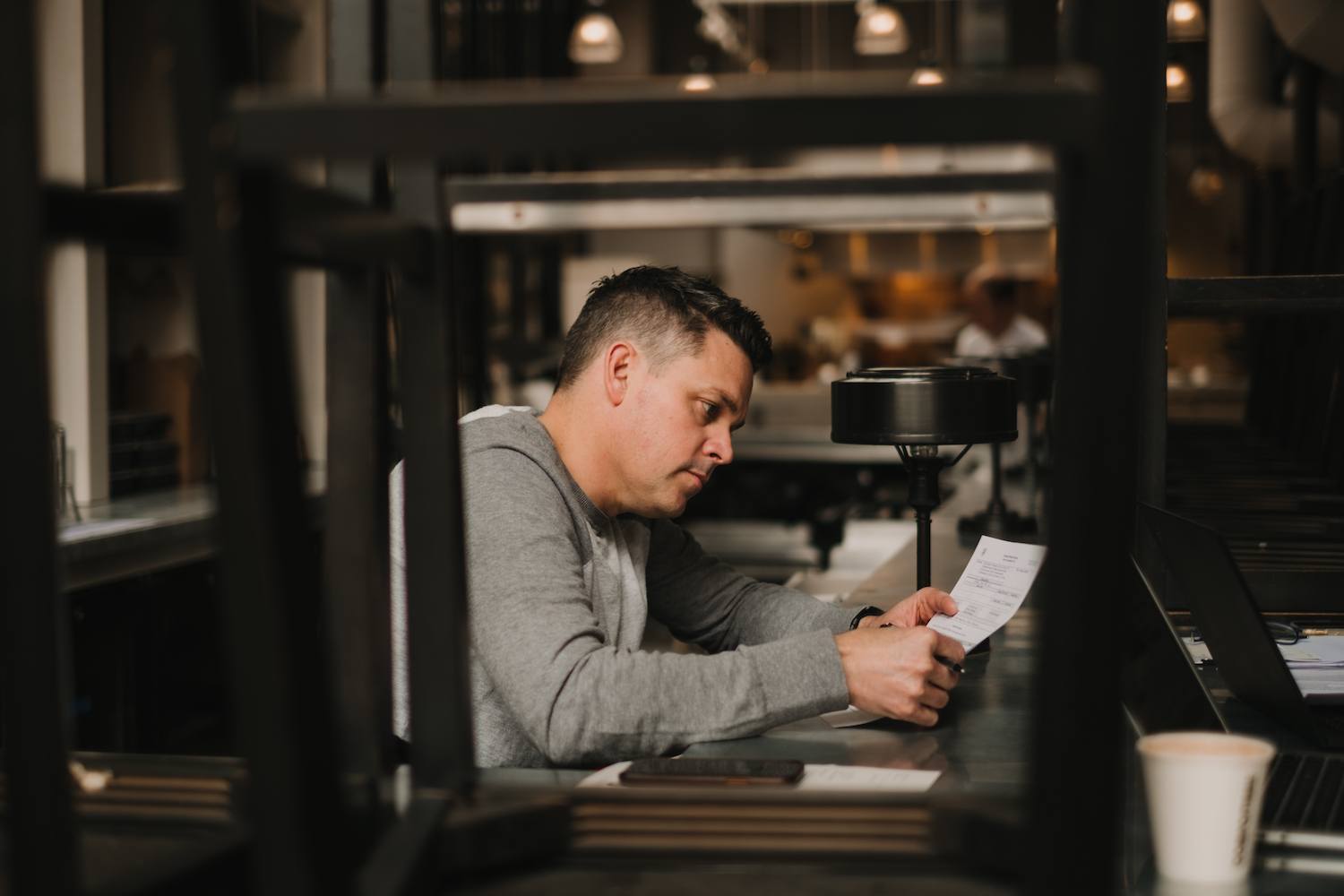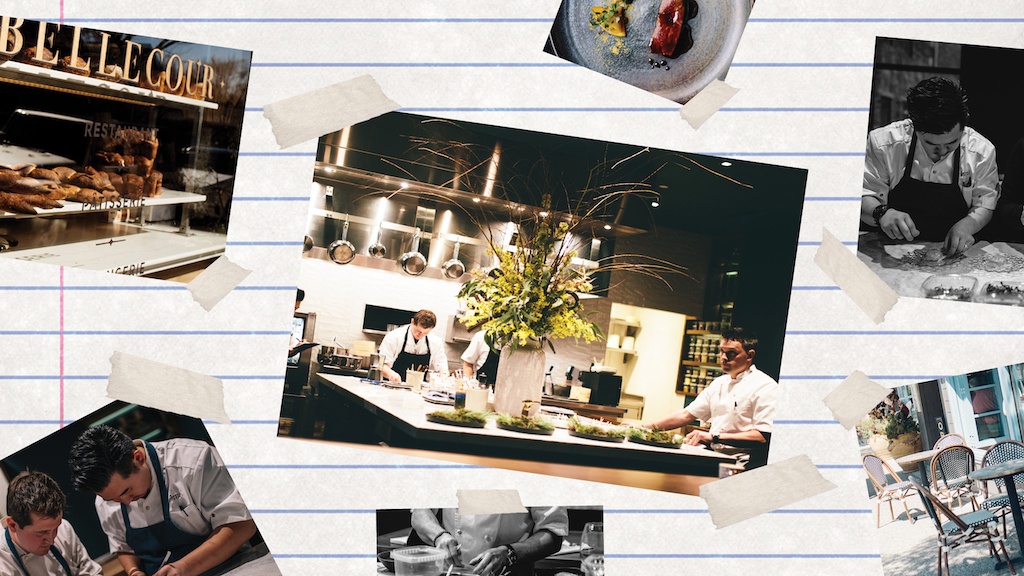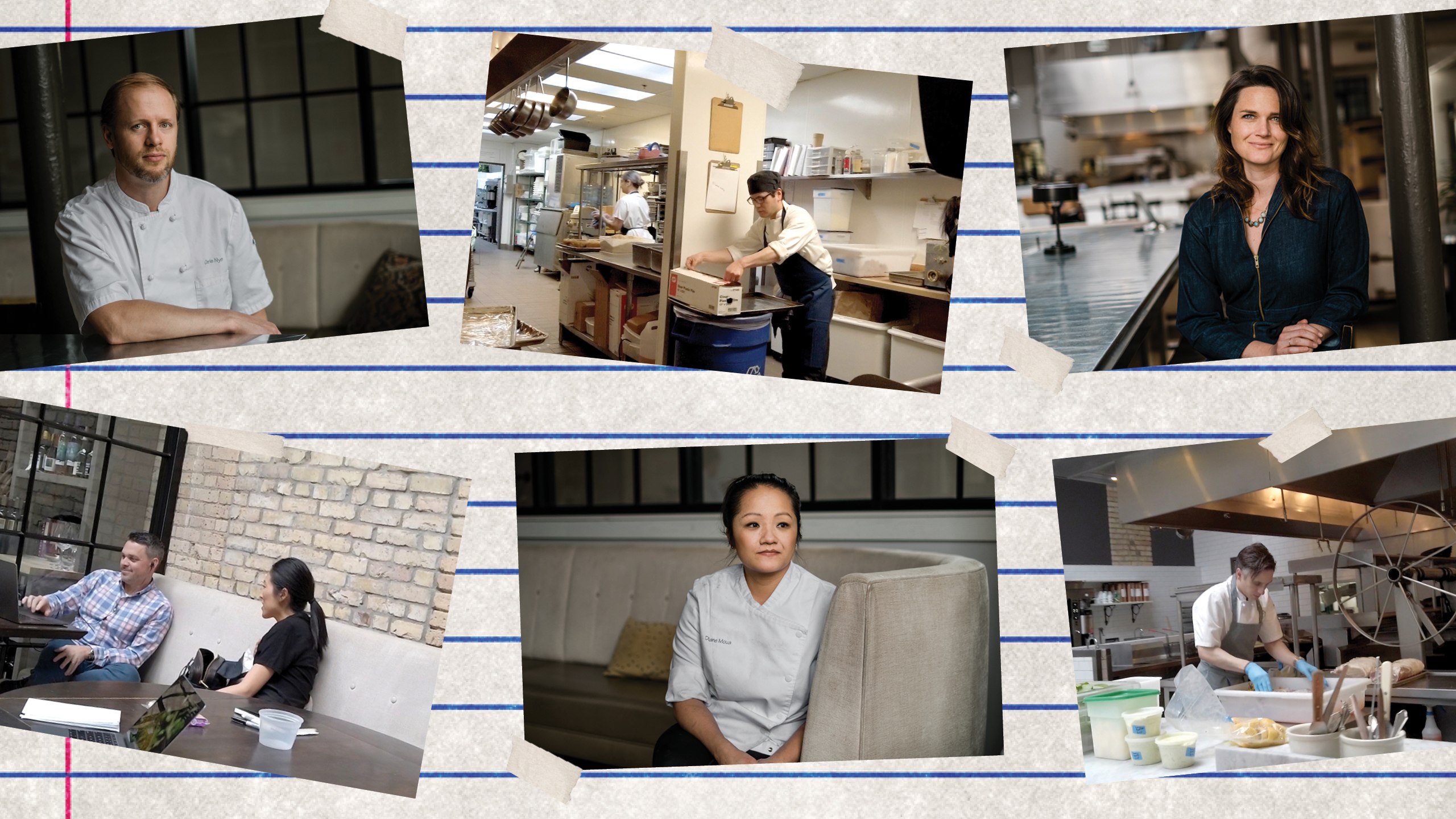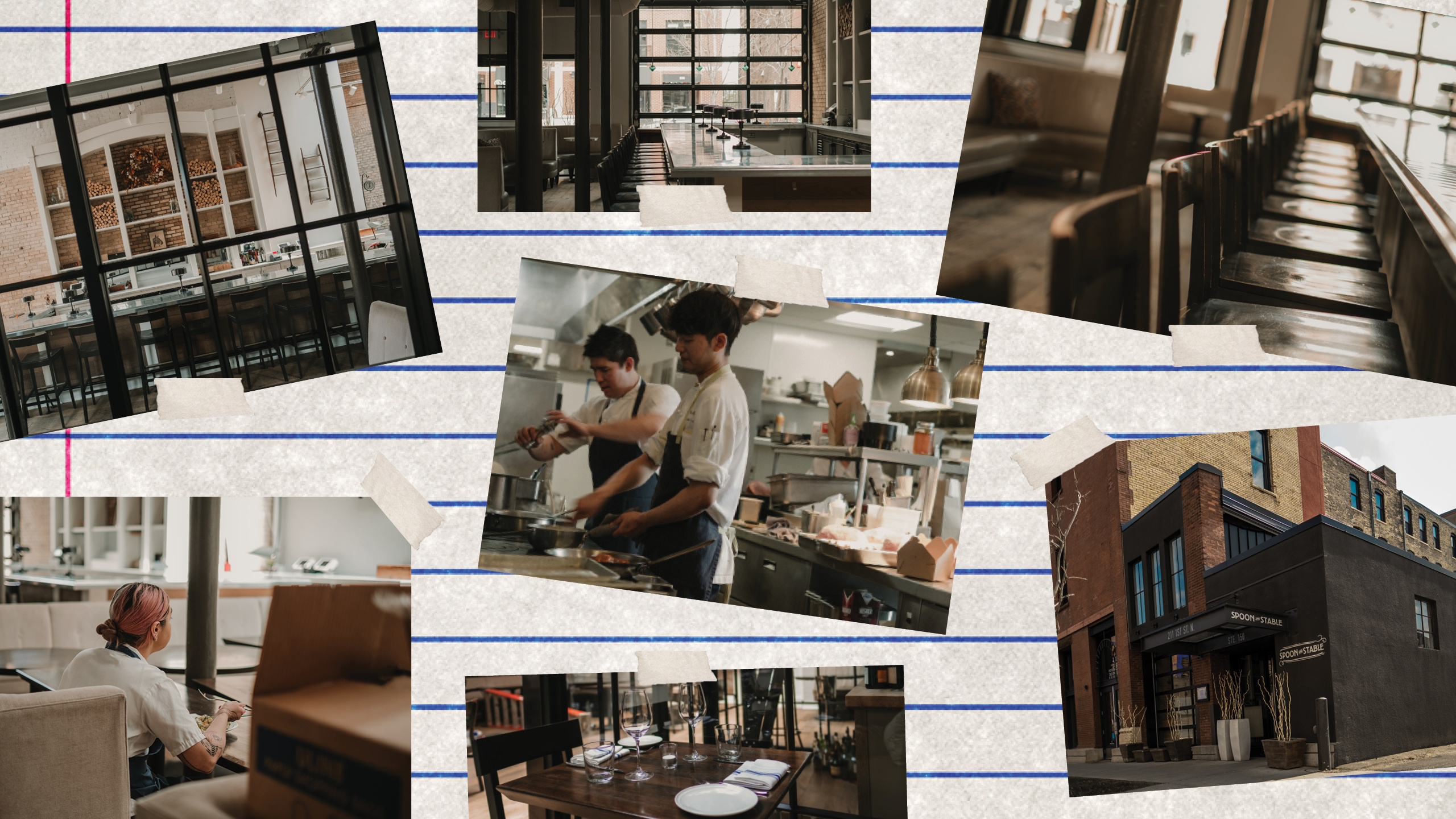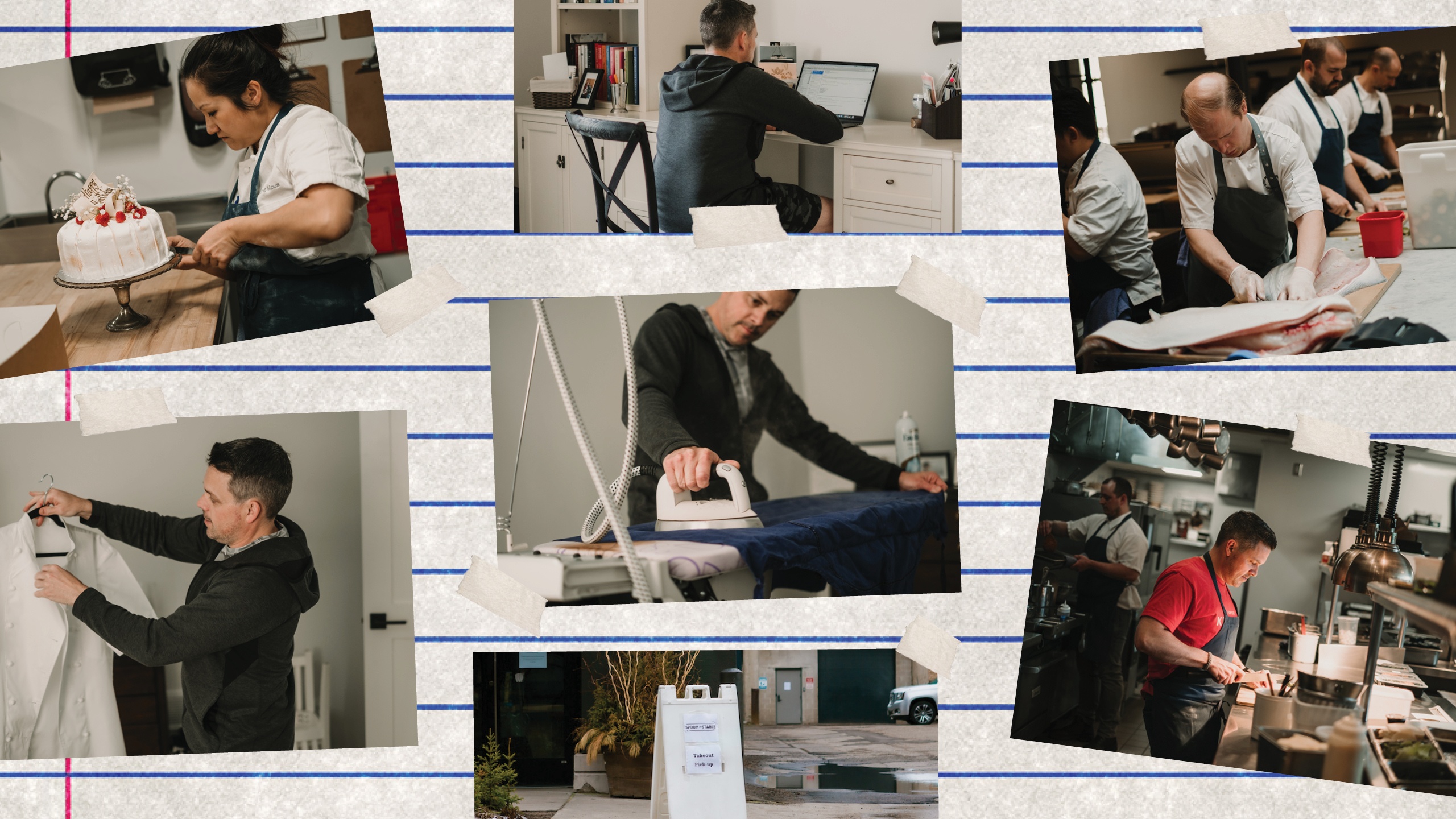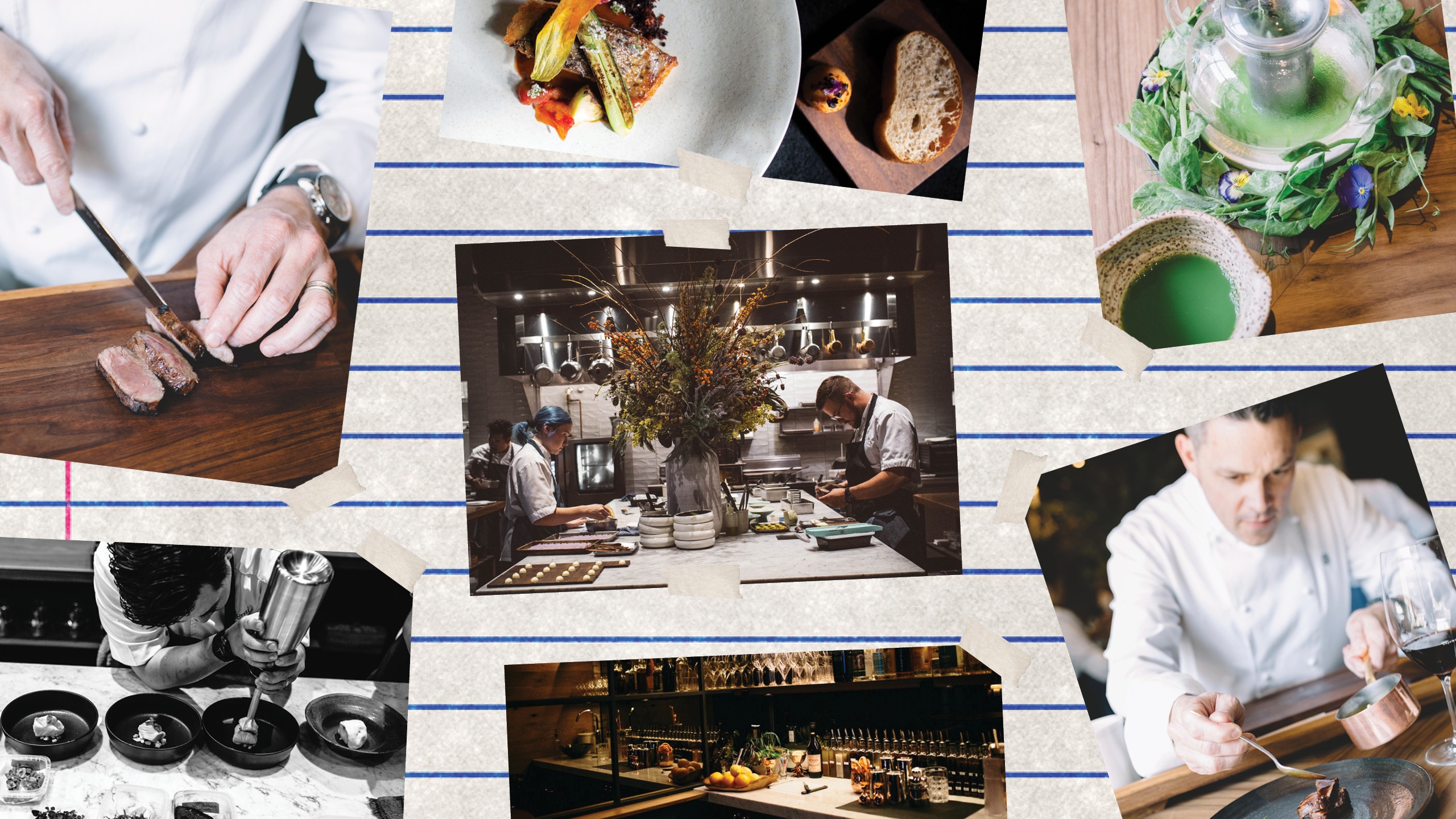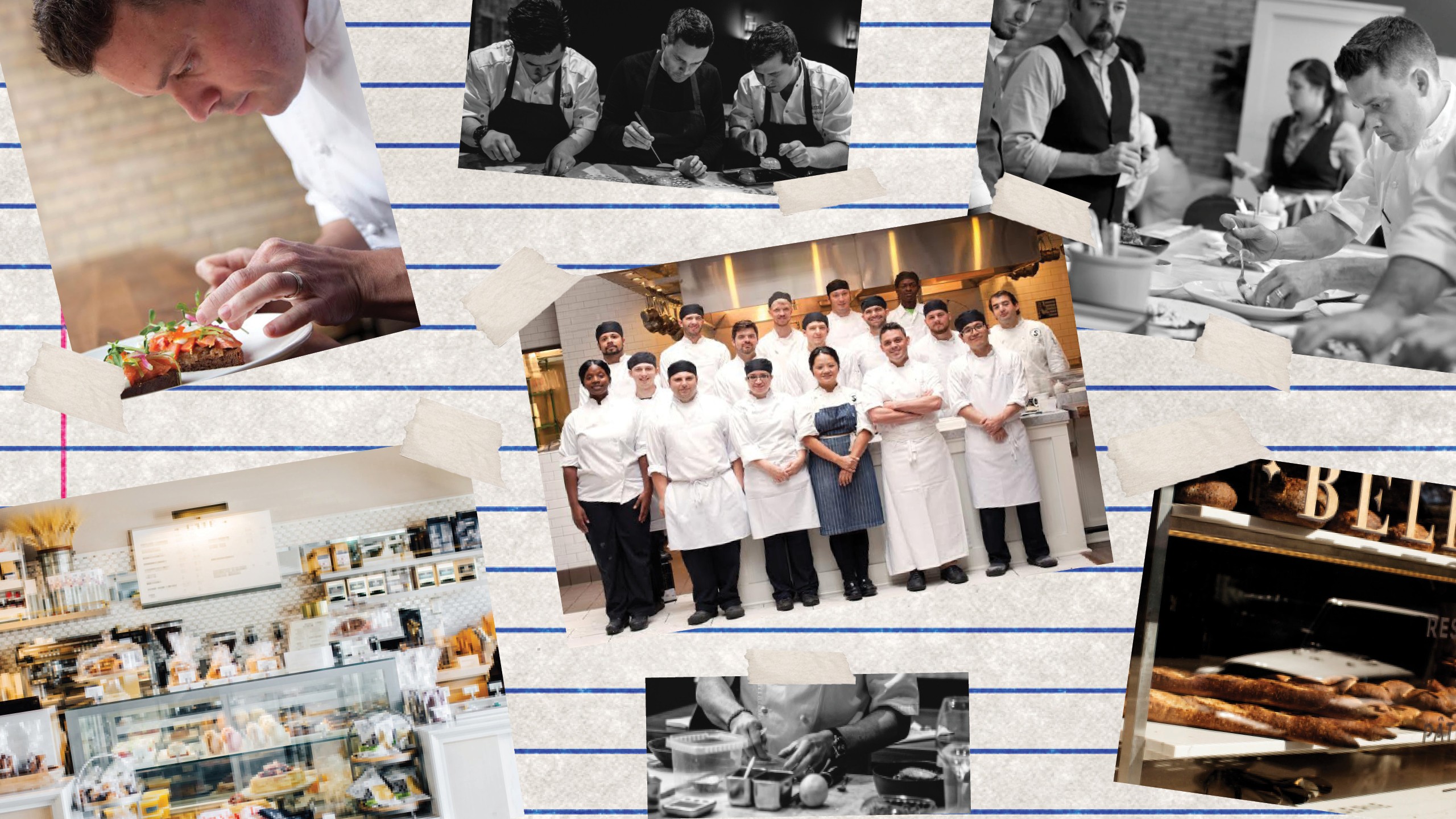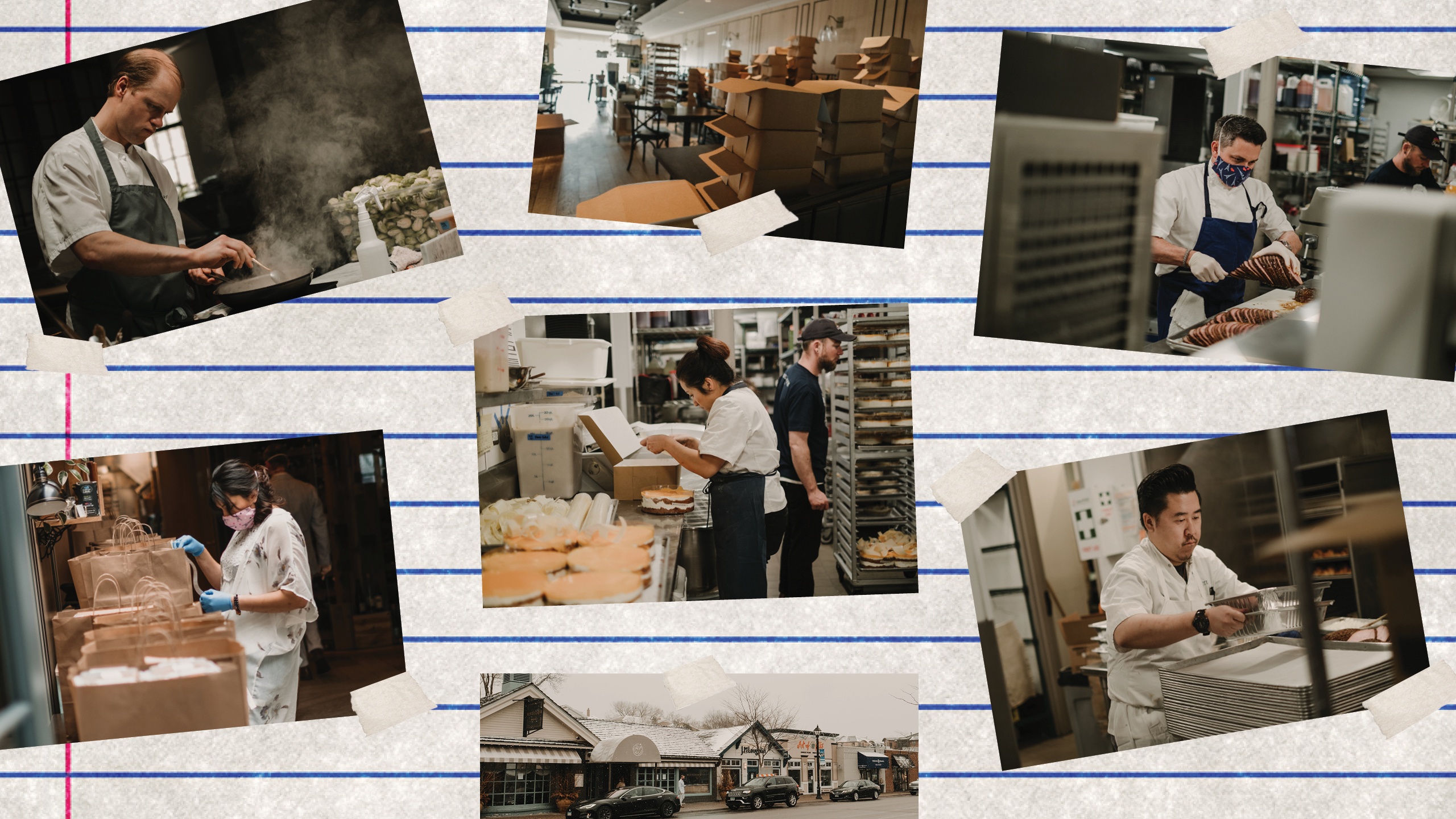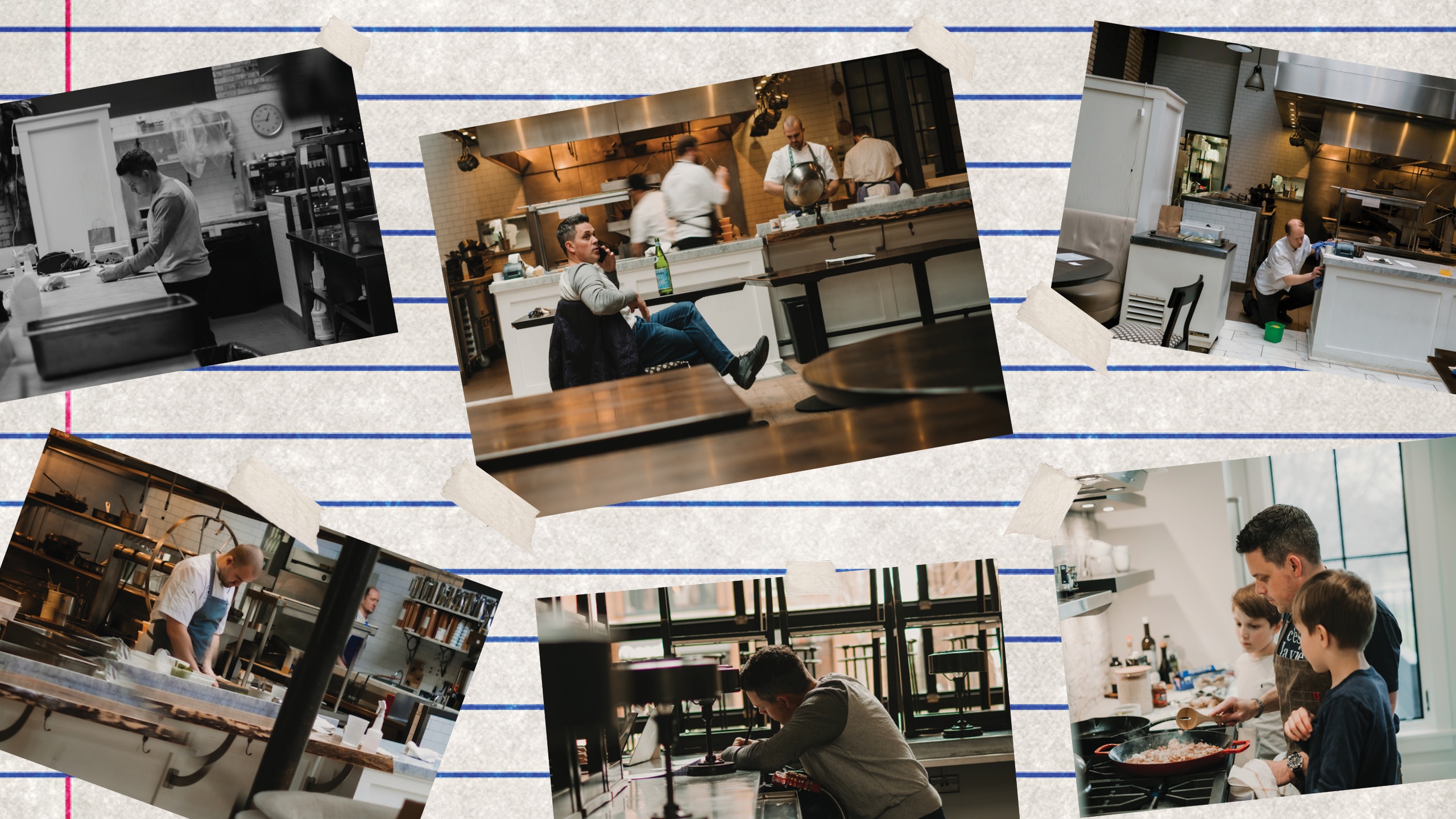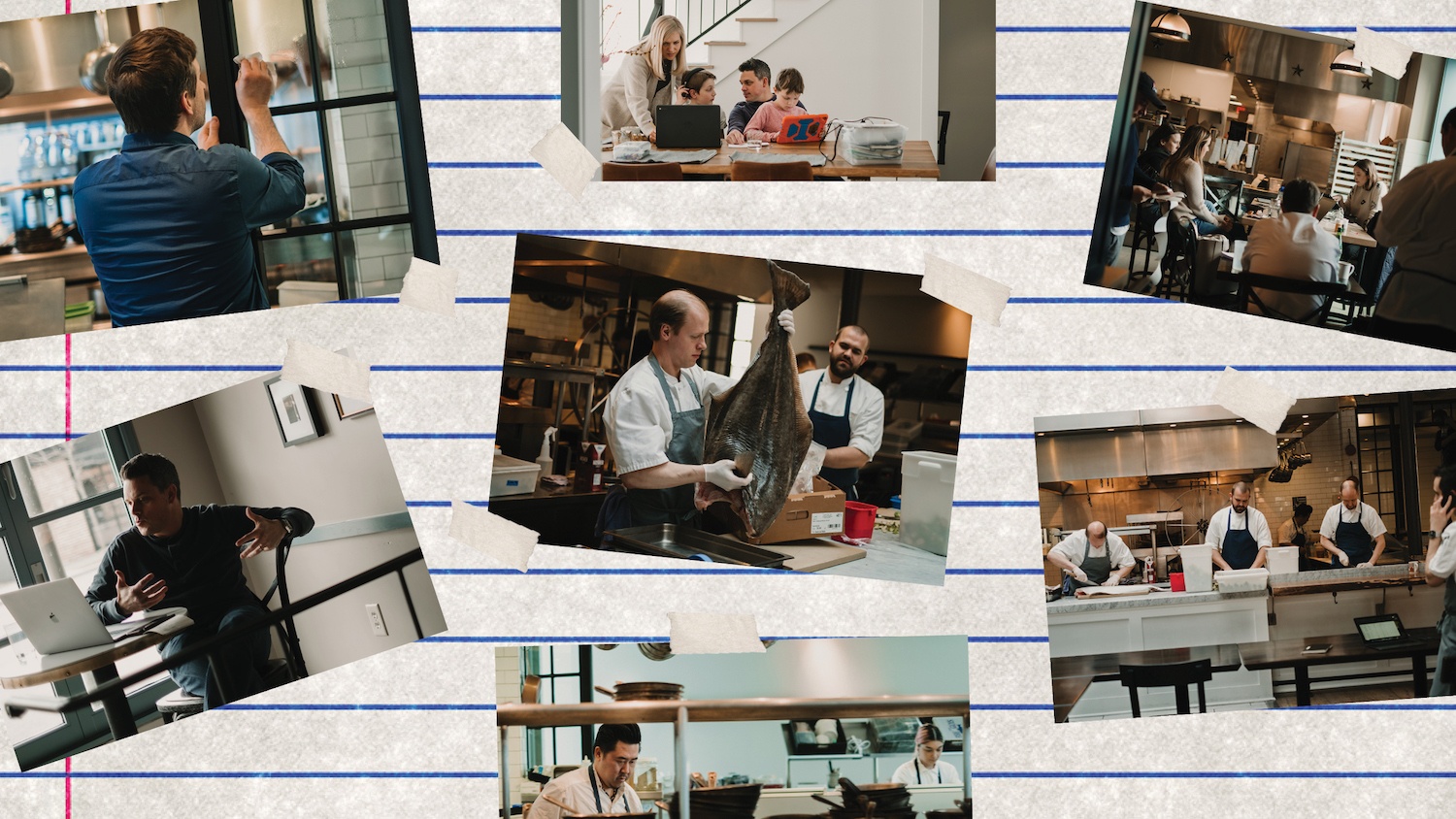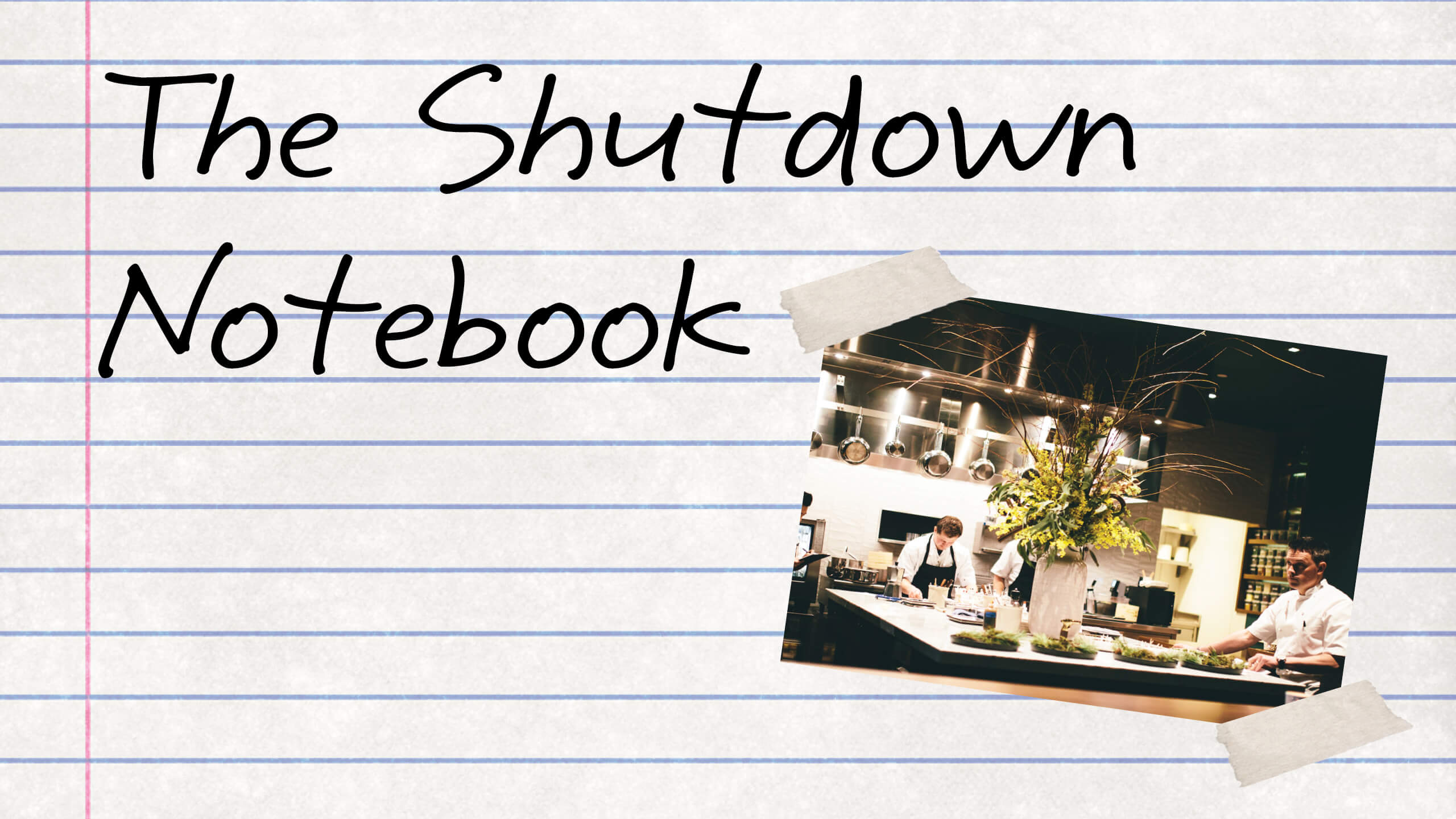
Photo by Libby Anderson/Flickr/Nicolas Raymond/Graphic by Talia Moore
A weekly series about one chef who closed three restaurants during the pandemic—and intends to get them back.
If a single word was thrust into the limelight by Covid-19, it is surely “pivot.” There are pivots big and small, from campus life to online universities, from supermarket lines to contactless pick-up lines—and three months into the virus era, they show no sign of pivoting into oblivion. We wake up to newly-discovered pivots, obsolete pivots, micro-pivots spawned by mega-pivots, at every step on the road to whatever normal will be.
If a pivot is a 180-degree turn—one foot stationary, the other swinging wide—then we are pivoting so fast as to have achieved pirouette, rotating on an axis, wondering when and where to stop. No wonder we feel so disoriented.
The word is enough to make you wince at this point, though it has hardly outlived its usefulness, and is a far kinder term than the equally appropriate “whiplash.” Gavin Kaysen’s company, Soigne Hospitality, pivoted in March from two fine dining restaurants and a bakery-restaurant hybrid to two take-out operations and a shuttered one. He has been waiting, as have restaurateurs around the country, to find out what the new state guidelines will be, trying to anticipate his next set of pivots.
Kaysen assumed that he would open Demi first; the 20-seat restaurant, with two seatings, five nights a week, was already the most controlled environment among the three places he owned. Fewer variables, easier to ease into the world of protected dining.
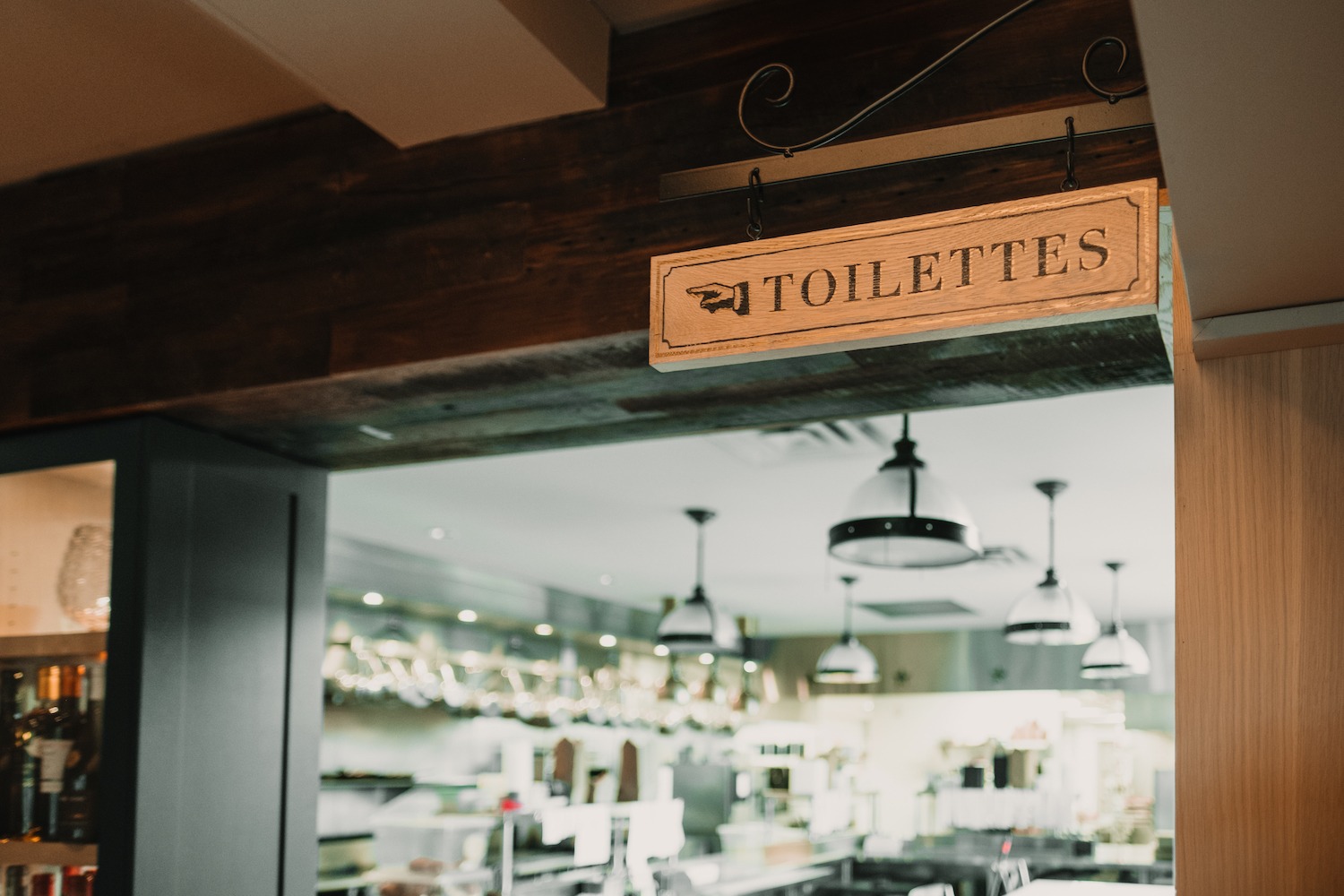
Gavin Kaysen must figure out how to accommodate indoor restrooms for customers when businesses can only legally seat people outdoors.
Dave Puente
Then Minnesota’s Governor Tim Walz announced the state’s new restaurant guidelines, and everything changed, a phrase that may soon overtake “pivot” in the overuse sweepstakes. Outdoor seating begins on June 1, but indoor seating begins who knows when, maybe late June, maybe early July, with the emphasis on maybe. As Kaysen said in an email to his managers, “There is no timeline on this right now.”
Just like that, Demi ceded the lead spot to Bellecour, which has a 38-seat outdoor patio, though outdoor dining, in Minneapolis, is a gambler’s sport: The day after the announcement, Kaysen considered a weather forecast that predicted rain for seven of the next 10 days.
It made his head spin, because any decision had so many subdivisions. He had to consult his managers, his bottom line, Mother Nature; he had to think about the competition, about the sweet spot between moving too fast and being left behind. He had to find out how to provide his customers legal access to the indoor restrooms. And he had to balance his normally methodical approach against an abnormal imperative: to start bringing in more revenue during high season.
—
The new frontrunner
Right now my to-do decision list for the week starts with, is Bellecour bakery on the docket for potentially opening first, or not? There’s so much we don’t know. The only way to get to the patio is to walk through the restaurant. We can ask people to come in at the back door, but then we have to establish a new consumer behavior.
And maybe that’s a gray area. What if a guest is on the patio and needs to use the restroom? They have to go inside for the restroom, anyway, so there’s an argument to be made that they can come in the front door as usual and walk through the restaurant to get to the patio—because those same guests will have to come inside to use the restroom.
The other issue, which is far bigger, is what happens if it rains: The forecast says there’s a chance of rain seven of the next 10 days, and the patio’s not covered. We could look into what it means to cover it, to put up a tent or something like that, find out the cost. But is it worth it? And what if it’s over in three or four weeks because indoor seating is allowed, and we have to repivot again? You have to wait, and think, What’s the return on my investment here if I spend $5,000 to build a patio and then we can go back inside?
And remember, if anyone wants to sit on the patio they have to have a reservation, even if they’re just coming by for coffee and a croissant. We have to say to them, By law we have to take your name and make a reservation. You think about it and it makes sense. And then you think again and no, it doesn’t make sense.
Opening Bellecour would give us an opportunity to test things out a little bit, figure out what’s right and what’s wrong.
I don’t really have a deadline to open Bellecour. I can survive with what I have; with today’s current staffing model and current revenue we are fine until July. Some of it’s scary. If the PPP forgiveness deadline doesn’t get extended, I have to open first week of July. If it’s extended, my flexibility on opening date is pretty free; it gives me a lot more flexibility. Otherwise, first week of July is when we would start to see loss of revenue, assuming that other restaurants around me are opening even with the limitations. That would take away some of my take-out business.
In some ways I don’t care if I’m first, last or second to last. It’s more about striking a balance, whatever that looks like. Weighing the safety of the team against not wanting to lose your team: If a lot of other places open up, people could say, Hell, why don’t I just go work for them? Such a delicate balance.
But I don’t want to be first. So I’m sitting, trying to figure it all out. I emailed my managers so we can start to talk about it.
Opening Bellecour would give us an opportunity to test things out a little bit, figure out what’s right and what’s wrong. That’s the whole thing. We’re stuck right now: How do we slowly start to unwrap all this? You don’t want to stick your neck out and say, We’re going to try it and see what happens. Then again, if it’s just the bakery it’s different. It’s croissants, coffee, baked goods. If you want a meal you still can’t eat it on the patio. You have to buy it and take it somewhere else.
Whatever date we choose, I’ll feel okay announcing it the day before.
—
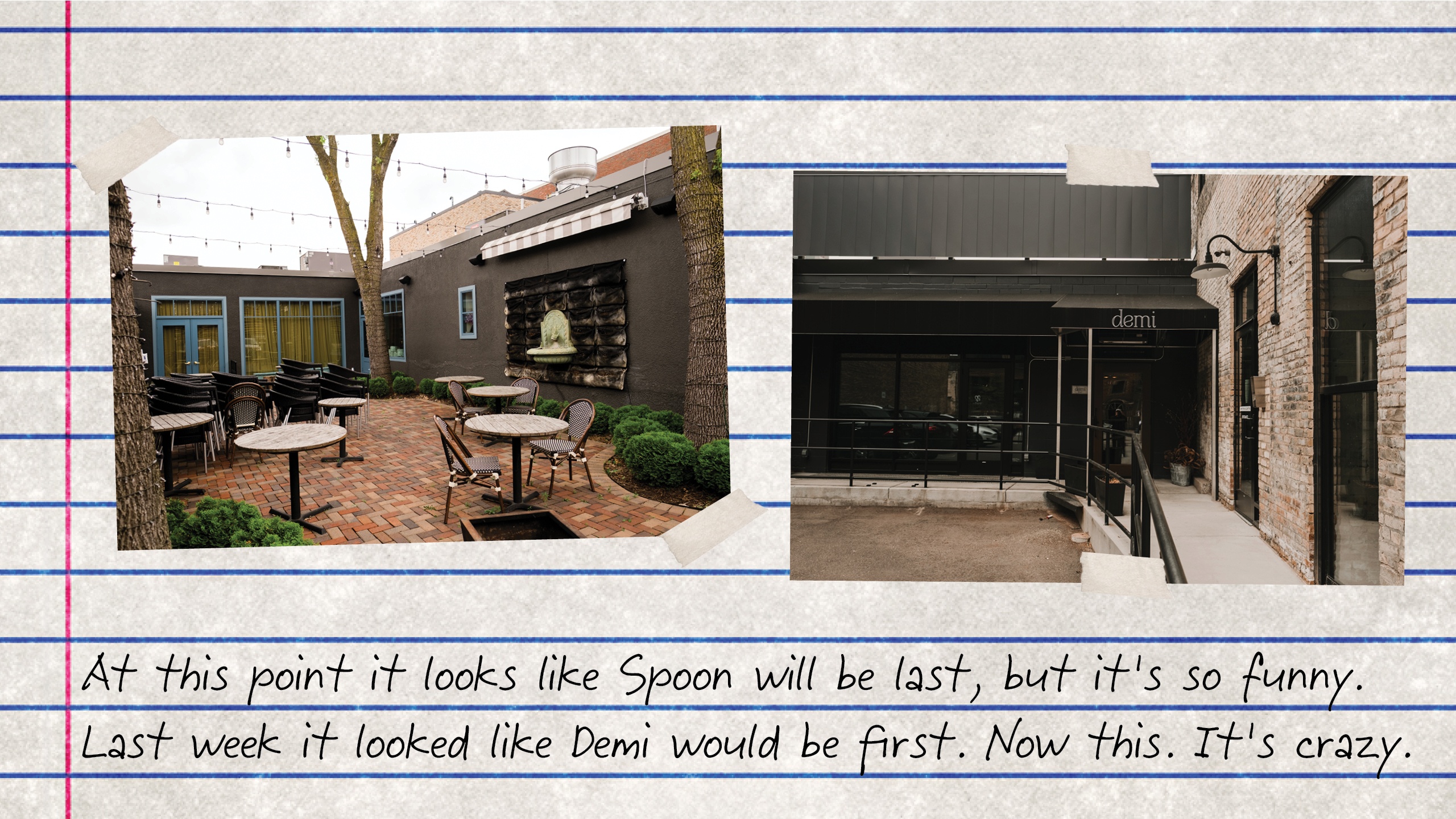
Dave Puente/Nicolas Raymond/Flickr/Graphic by Talia Moore
The old frontrunner
I was just thinking, you know what else would be fun? I have a small sidewalk patio at Demi, room for one table for two if we think about social distancing. What if we just said, Demi is open five days a week, one table per service, four people per night, price will be whatever it is and that’s it. It’d be fun.
There’s an optics issue there, it is a little bizarre—lots of people are not in great places right now and we open this expensive one-table restaurant. It’s not out of the question, but it is a crazy idea. One table of two? This is it? We used to do 40 people a night, now we do four. Ten percent occupancy, down 90 percent in revenue, but hey, we’re cooking. Not a bad idea.
It would be interesting. It’d be fun, and it’d be important to start to train ourselves to work in these spaces with customers who have felt uncomfortable up to this point.
I wrote an email to our top leaders, I was feeling pretty vulnerable, and I said, I know we’re in a time of uncertainty and I’m going to be very honest. I don’t know the right answers, but we will figure them out together. If I do something wrong or something that disturbs you, please tell me. Keep in mind that we’ve been living in a bubble for two-and-a-half months.
It’ll take 10 days of training and prep, so we won’t open June 1, not even close. If we were on top of everything, which at this point is so hard to do, there’s so much to do, the very earliest would be June 10.
Sequence is the key in all of this. At this point it looks like Spoon will be last, but it’s so funny. Last week it looked like Demi would be first. Now this. It’s crazy.
—
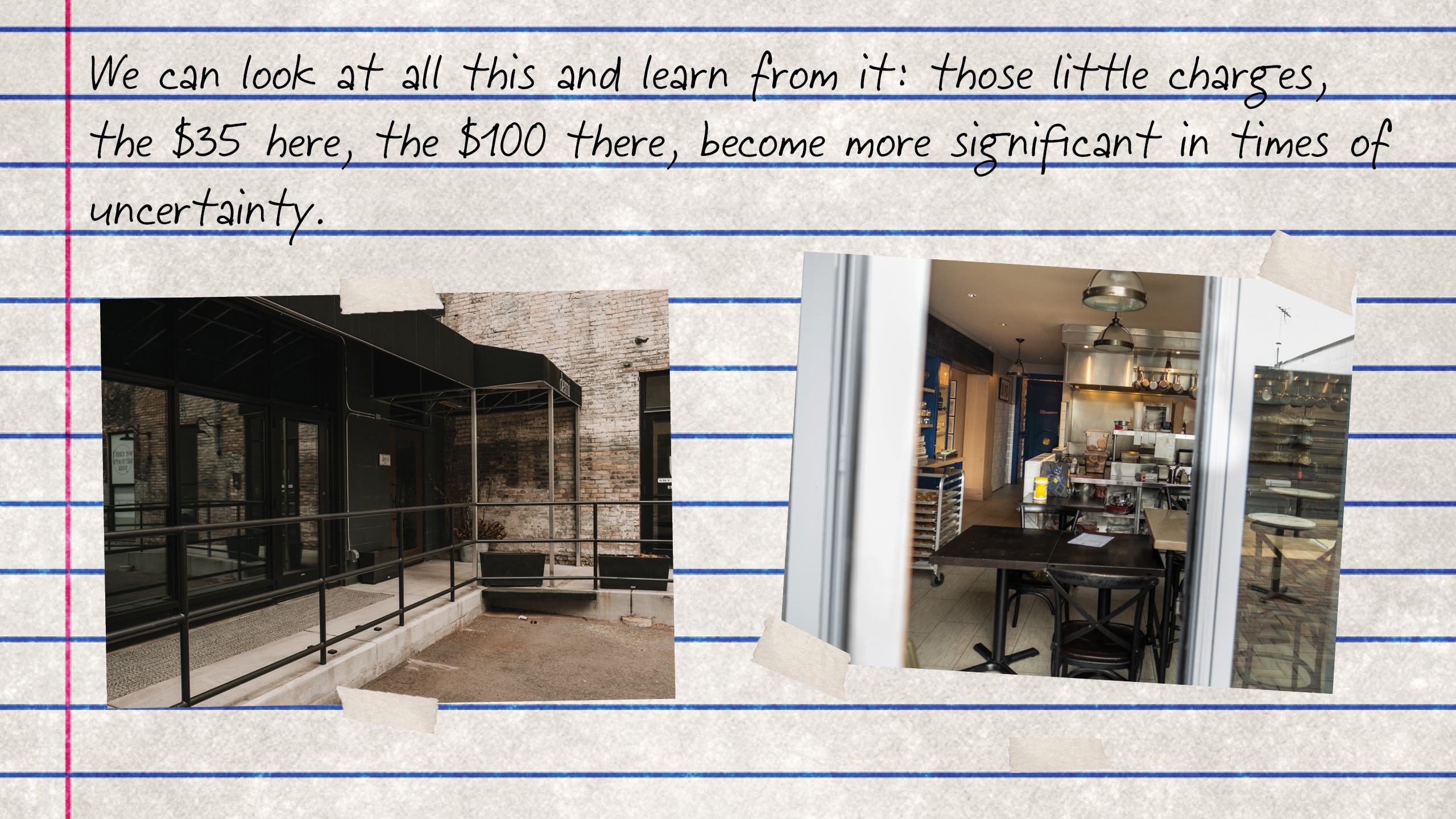
Dave Puente/Nicolas Raymond/Flickr/Graphic by Talia Moore
Doing the math
The biggest thing in all of this is return on investment. We’ve pivoted to take-out, but a lot of restaurants are doing so many different things. One thing I take away? Pivot to one thing and absolutely kill it. Do it right, make it profitable—and then wait. It’s going to change. A guy texted me today, he owns a shop across from Spoon with a parking lot, and he wrote: I have this lot, it’s huge, it’s empty, if you want it, you can have it. But it’s 500 yards away, that’s a long way to walk with food. It’s a great offer—but how much time and energy and money will it take to put up a tent, and what if on June 2 the governor says okay, we’re at 50 percent occupancy as of June 10? We’d have to stop everything we were doing to go back to opening our restaurants.
We had a dream meeting with our Spoon landlord in the beginning, six or seven years ago, talking about what we wanted to do. I reflect often on that meeting. If anything happens, it’s so easy to address. Here’s an example: Our rent bill had a new $35 charge to read the meters, never happened before, popped up around Covid. I called up to say, Hey, what’s this, I called the president of the company that owns the building and he said, Don’t worry, that won’t appear on your bill again.
We always look at all the charges: we want to know what we are paying for, where’s the value to it. Everybody at this point is trying to restructure deals, now that we’re into this, but we have to remember that this is not going to last forever. I’m not going to call it normal, but things are going to get back to not being like this. We can look at all this and learn from it: those little charges, the $35 here, the $100 there, become more significant in times of uncertainty.
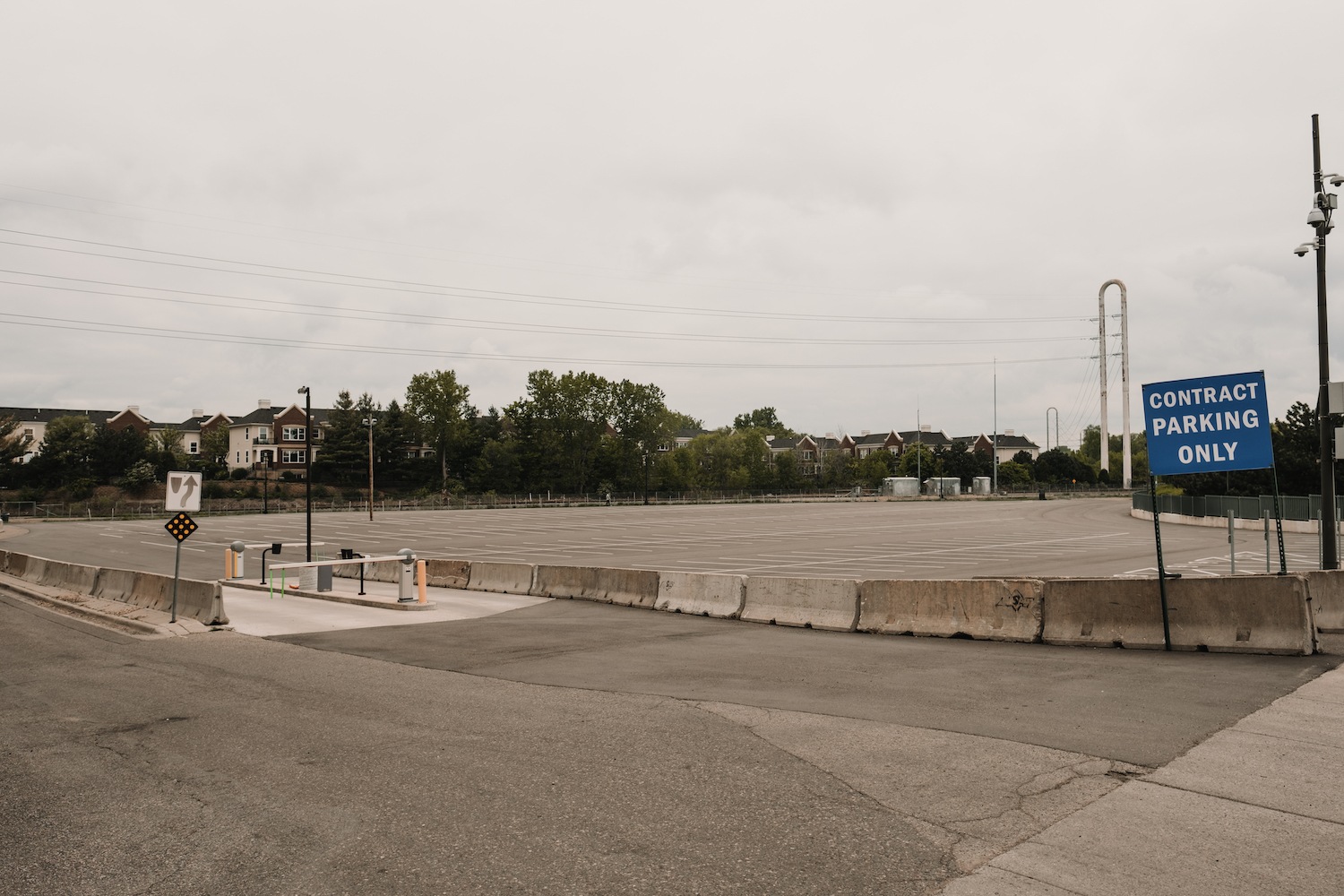
A parking lot across from Spoon and Stable that could potentially be used for outdoor seating
Dave Puente
I’ve always been this way with numbers. When I used to sign the checks for vendors at Spoon and Stable, I could memorize the numbers on 100 checks, and I could guess the total. I was usually off by no more than $100. It’s a game I like to play.
I saw that Danny Meyer said he’s not opening some of his restaurants until there’s a vaccine, and part of me wonders how that can be, if he owns more of the buildings we don’t know about. But one thing I’ve learned, consistently, and I remind myself of when I hear how somebody else does business, is that everybody’s deals are so different. I say this to people who want to go out on their own, and what advice do I have: Every deal is like a snowflake. They all fall differently. Don’t say, I want my deal to look like so-and-so’s unless you’ve read every piece of paper so-and-so has. You have to make your own deal. You just have to be aware that you can make a really good deal with really bad people, or a really bad deal with really good people.
—
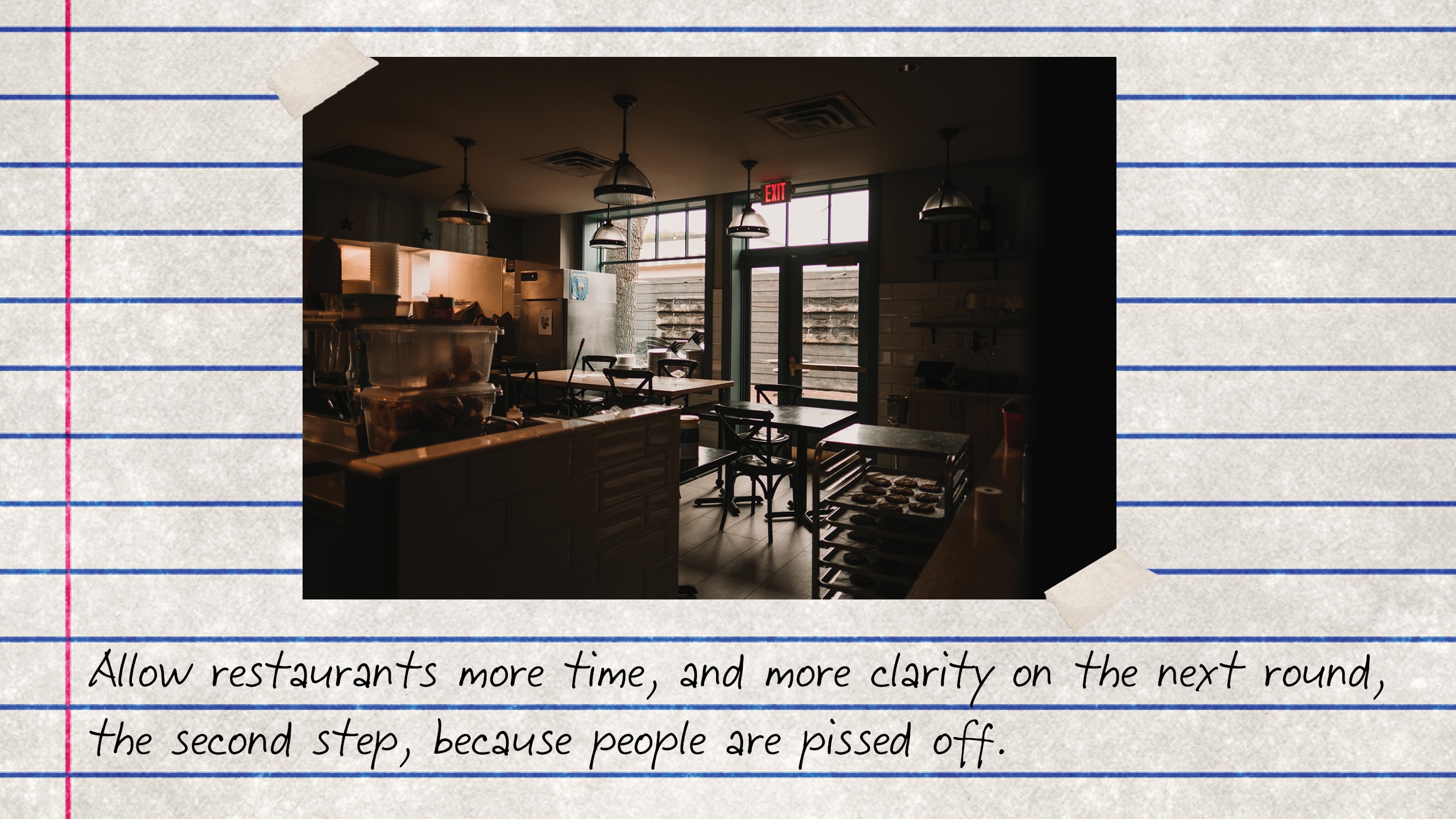
Dave Puente/Nicolas Raymond/Flickr/Graphic by Talia Moore
Playing by the rules
The morning the governor announced guidelines, we were on a call with the Twin Cities Restaurant Coalition leadership. I was on Twitter during the call because I was looking for leaks, though our governor doesn’t tend to leak stuff.
But there it was, from NPR Minnesota, a credible source: No indoor dining, patio only. The next phase would be 50 percent dining capacity indoors, but there was no date for that, we didn’t know what it would look like. But during the press conference, they mentioned a 14- to 21-day window where they work to understand the scientific results of their decisions. If I read between the lines, then maybe by June 22—21 days—it would be possible to see restaurants opening their indoor spaces at 50 percent.
If I could sit across the table from the governor, I’d say, Allow restaurants more time, and more clarity on the next round, the second step, because people are pissed off.
I don’t think it was intentional, but when he came out a week earlier and said, we’ll re-open on June 1, and we’ll be back in a week to tell you what that means, it allowed people’s imaginations to run free. A lot people thought, If we can even get 20 percent occupancy we’ll be okay, so they started hiring people back, used their PPP money, started to order food.
Then the gut punch on May 20: outdoor only. A lot of restaurants don’t have that capacity, so they’re stuck. And the next round, 50 percent occupancy? He needs to give restaurants more time to prepare. He needs to start working on this now, to come out by June 5 and give us the details of how that works.
—
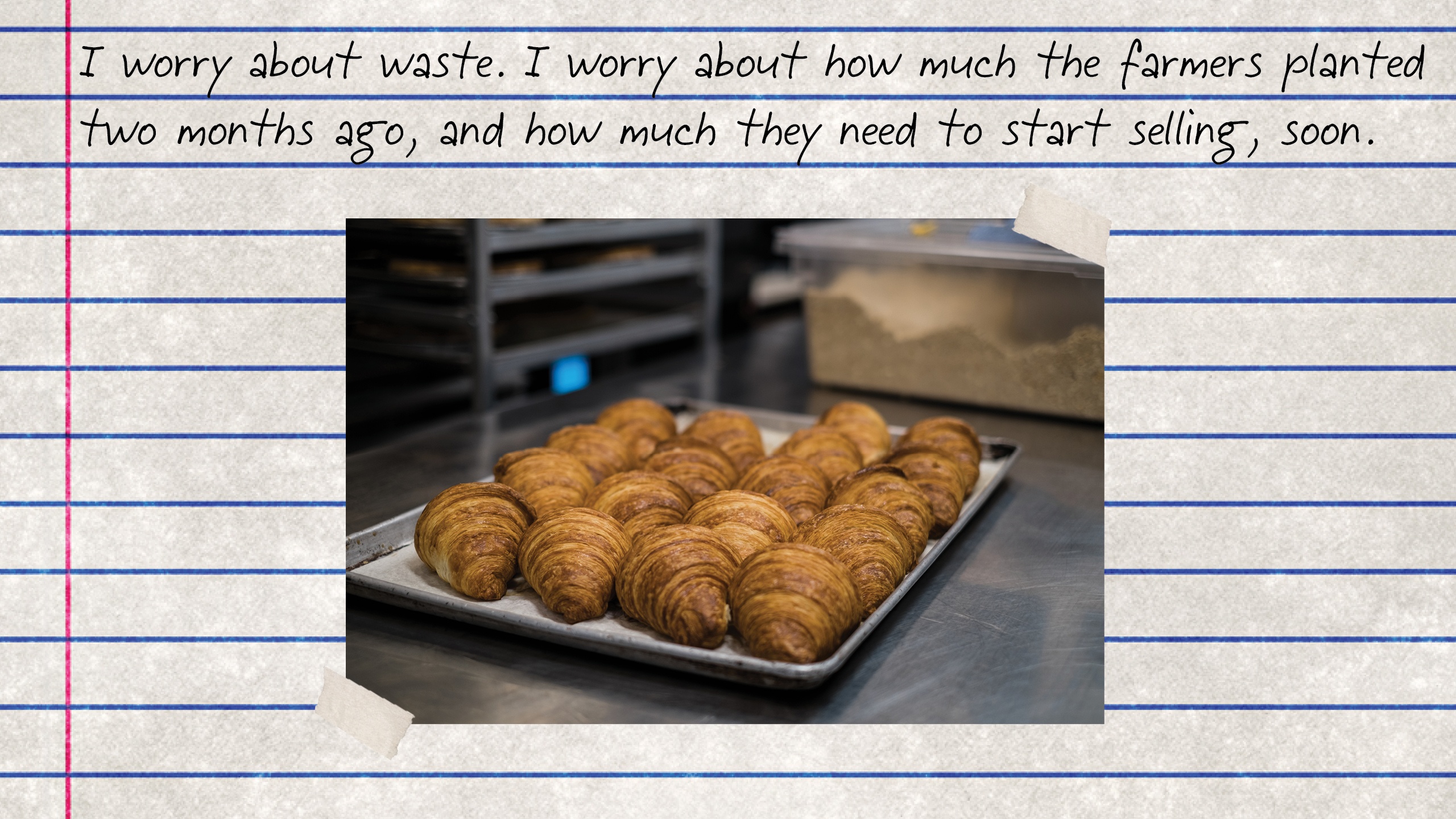
Dave Puente/Nicolas Raymond/Flickr/Graphic by Talia Moore
Prep work
I’ve built my career on strong foundations—cooking, business, leadership. I can’t be quick to make knee-jerk decisions, because that’s where you make mistakes. I don’t want to go to bed feeling I’m falling behind, with that sense of urgency. That’s when things get sloppy.
We’ve been paying all the landlords, all our rent, all our sales tax, and slowly chipping away at our block of vendors, doing the best we can to pay them in a timely fashion—slower than normal, but communicating constantly.
Maggie, who handles the payments, is our diamond in the rough, and the only reason it’s rough is because these are uncharted waters. She’s crushing it, giving everyone some clarity. Sometimes they send automated payment notices, “We’re looking for a payment of X amount,” and I’ll write back and copy Maggie, only to find out that she’s already taken care of it. Or the vendor will be copied because it’s automated, and they’ll reach out to say, Don’t worry.
And we know which vendor needs a payment right now, and who doesn’t.
Since we’re doing take-out we already have the supply chain working, so that could be ready in a couple of days. But I worry about the suppliers; it’s a real issue. Most places will open with an abbreviated menu because your staffing level is different. If you’re serving less people and your menu is smaller than before, your demand, produce-wise, is substantially less, too. I worry about waste. I worry about how much the farmers planted two months ago, and how much they need to start selling, soon.
For them, like us, this is a constant battle.
—
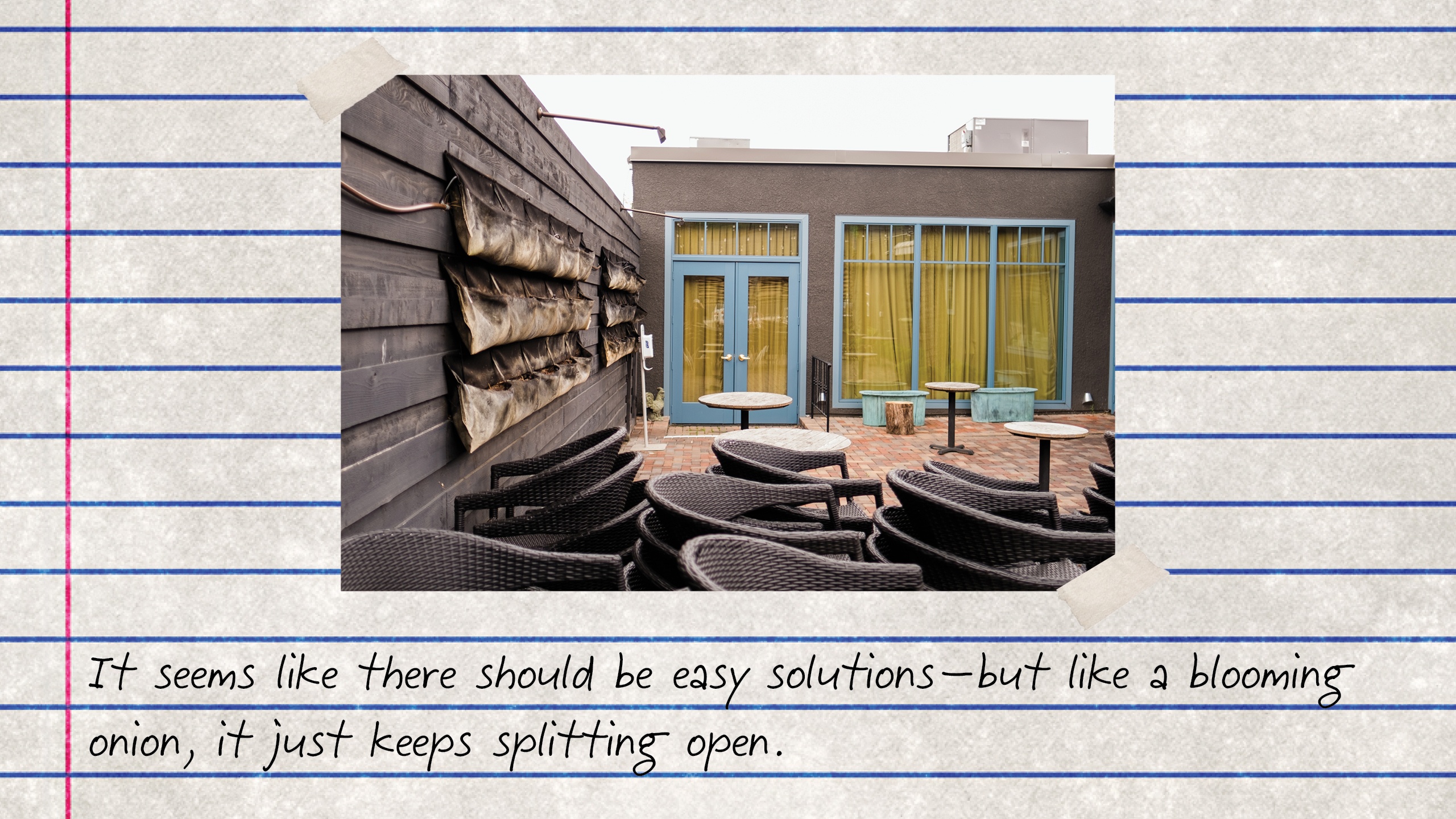
Dave Puente/Nicolas Raymond/Flickr/Graphic by Talia Moore
Mental health
Today I woke up with a sense of urgency, or maybe anxiety, too, because of the governor’s announcement, though I’m not sure where all of it stemmed from. I’m feeling pretty stressed by everything because there’s so much decision-making to be done. It’s hard to know what’s right and what’s wrong.
Rather than putting too much focus on that, I have to do what I know is correct in my heart, what I believe in, what the team believes in, collectively. I emailed the team to say, Some weeks I feel great, some weeks I feel defeated, some days I feel inspired by what’s going on around me, and some days it’s, When is this going to fucking end.
I try to balance that. On the other hand, I’ve never spent this much time with my family, ever. I’ve never been able to kiss my kids good-night more than I have recently. I’m still trying to find time to reflect on all this, to think about what’s happened, what’s happening, and what does it mean. It’s just hard to find the head space.
When I need to create a little bit of that space, I put my headphones in and don’t listen to anything. Nobody will disrupt me because they think I’m listening to something, but it’s completely silent. And so gratifying. And Sunday I took a nap. It was cold, pouring rain all day. I came up to my room to do a radio interview in the afternoon, laid on the bed, turned on the TV and woke up an hour later. That felt good.
We have to pull back and say, Where do I want to be long term? How do I not detract from who I am, not detract from the brand, who we are, what does that mean? It seems like there should be easy solutions—but like a blooming onion, it just keeps splitting open.
So you just have to quiet down your own head; that’s what I tell my team. I said yesterday: We do not have to open. When I tell you my thoughts, that is not designed to give you a sense of urgency. We have to think it all through.
